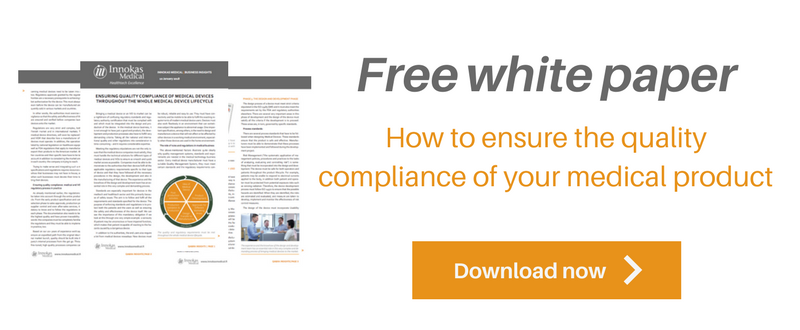When you’re working in medical industry, it’s a fact that regulations and standards are something that companies need to follow and they’re coming stricter for everyone continuously. This is primarily because of safety reasons; the purpose of enforcing standards and regulations is to protect both the patients and the users as well as ensuring the safety and effectiveness of the devices itself. The aim is to follow and fulfill all the requirements and standards specified for the device.
Related to that companies need to meet the certain standards and the regulatory requirements concerning medical devices, every medical device manufacturer must have a suitable Quality Management System as well. The management with executive responsibility must ensure that an adequate and effective quality management system has been established, defined, documented and implemented at the organization.
The QMS can be seen to be one key to ensure the success in the market. But why? Well, the well-established quality management system helps the companies to comply with current regulations as it establishes the company processes in a way that those align with regulatory expectations. In other words, QMS is not only one mandatory thing among others that medical companies need to deal with: it’s something that helps your company in your everyday life as it establishes a framework for how your company does your business, align with the standards and regulations.
If you’ve seen QMS only as an evil mandatory process, you should definitely continue reading this post as it shows you the reasons why QMS can be seen as key to your success!
QMS helps you to perform align with the standards and regulations – every day
QMS standard establishes a framework for how you do your business – every day. It covers all processes related to the medical device’s development, manufacturing and maintenance throughout its whole lifecycle. It includes also guidelines for purchasing, human resources and document control related to the medical device etc. Post Market Surveillance is also built into the QMS.
In addition, the QMS includes the preparation of the Quality Manual, writing of the SOPs, describing needed processes and their interactions, and the preparation of templates for different kinds of documents and records that will be needed. These are subjected to very careful scrutiny by Management Reviews, internal audits and CAPA procedures to deal with, and correct any non-conformities detected to keep the Quality Management System effective.
In the medical field, the best way to establish a quality management system is to build it in compliance with ISO 13485 standard. In addition, it should be in compliance with FDA 21 CFR part 820 (QSR) if company seeks US markets. If your QMS meets both ISO 13485 and FDA QSR, there’s a pretty good chance you are going to be in good shape with most medical device regulatory bodies. If you are outsourcing your design and development and/or manufacturing of a medical device, the Quality Management System of the subcontractor is a must to mitigate both business and product risks.
Speed-up time to market: implement your QMS already from the get-go
What you need to understand is that QMS efforts need to be started already right after the idea phase, because it need to be in place already during product development. The design process of a device must meet strict criteria stipulated in the ISO 13485 QMS as well as FDA 21 CFR 820.30 Design Controls; the design of the device must satisfy all the criteria if the development is to proceed. These areas are, in turn, governed by specific standards.
Complying with Design Controls (FDA 21 CFR 820.30 and ISO 13485:2016 7.3 Design and Development) is key to developing a quality product. The US Food and Drug Administration (FDA) and other market regulators require proof of compliance with established design control procedures for most medical devices. When you develop a product under design controls and create the documentation required by Design Control you have an easy and practical way to demonstrate the compliance. Keeping up with your design history file will probably e.g. make your 510(k) submission easier. Then you have evidence to prove that you’ve designed your device properly and tested it.
Medical device engineers, just like other engineers, want to focus on solving technical problems and to create as functional device as possible. To help them you should give them an easy way to create the needed documentation for demonstrating compliance. This can be done by well established Quality Management System.
QMS guides you throughout the device whole life cycle
After the design & development phase, the medical device will be transferred to manufacturing. The device must be manufactured to a high consistency according to ISO 13485, GMP, and FDA requirements and standards throughout the entire manufacturing process. That’s why it is extremely important that the manufacturer or production facility is compliant at least with ISO 13485 requirements. FDA registration is required also if the company seeks for US markets.
When a company manufactures a complete device for a client (legal manufacturer), a Notified Body would see them as a ‘critical subcontractor’. Critical suppliers may also be audited without prior notice by your Notified Body. You would not like to risk your compliance status, and therefore a well-established Quality Management System should be a must for your contract manufacturer. As the legal manufacturer and the contract manufacturer must work closely together, a manufacturing quality agreement in line with ISO 13485 beneficial so that the responsibilities of each party can be clearly defined.
Corrective and preventive actions (CAPA) procedure is an effective tool with internal audits to see the status of your QMS; it is an indication of how well other processes are managed. You should check if your critical contract manufacturer has an effective CAPA system in place, as well. In addition, the well-established QMS will give a legal manufacturer a transparent visibility of the production of their product: production and process control define and demonstrate how the contract manufacturer is controlling the process to ensure that they are producing a well-designed, safe and effective devices.
One important thing, among the others, is also that the life of a medical device does not end when it is sold to a customer. Post market surveillance is a collection of processes and activities that are used to monitor the performance of a medical device. QMS is something that helps you deal with the processes during that time, as well.
Recognize the regulatory process of the device lifecycle as a whole
At least we see it quite clearly: the well-established QMS does not only limit and impose regulations to you – it guides and HELPS you to do things right, and gives you visibility to your product throughout the device whole lifecycle. That’s why we see that QMS really is one key to company's success: to ensure an expedited path from the original idea to the final market launch, quality should be built into the company’s internal processes right from the get-go, and implementing QMS and performing according to it is one way to do that.
What you should also remember is that QMS is not the only thing you need to implement and follow. All the other standards and requirements must be taken into account, too. To read more about the regulatory process of the whole lifecycle of the device, you can download our White Paper including insights related to that. It shows an illustrated outline of the stages in developing your idea into a worldwide selling product in the medtech/healthtech sector. These phases demonstrate how to ensure compliance to enable medical devices to be placed on the market as smoothly as possible. Please download your free white paper below!











